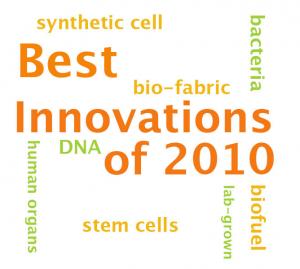

Towards the end of the year, I typically read quite a few top 10, 20, or 50 lists of music, books, or movies. One list that I read, however, was more unique - Time Magazine's "50 Best Inventions of the Year." It struck me because not only was it interesting, it was one that involved chemical and biomolecular engineering, a subject near and dear to my heart. Following are a few examples of some of last year's most exceptional innovations that really raise the bar for 2011.
Synthetic Cell

The third item on the list is the first synthetic cell, created by J. Craig Venter, who is best known for mapping the human genome. This invention utilized synthetic biology to string together DNA to make the bacteria. Venter hopes that this technology will help generate new bio-fuels and improve production of vaccines.
Lab-Grown Lungs
The twelfth item on the list is lab-grown lungs (I had previously seen a bladder and esophagus grown using stem cells). Obviously, the goal is to help patients with emphysema and lung cancer. As I have known several people who have been afflicted with these diseases, I can imagine the impact of such an invention. Also on the list is a dot-matrix printer for human organs. This concept would seem to have a long path to commercial development.
Textile Innovations
Another item needs improvement by chemical engineers, but is an interesting concept - a bio-fabric manufactured by bacteria. The only problem, according to ChemE Alexander Bismarck, is that the fabric absorbs water if it gets wet! An additional concept on the list is spray-on fabric developed by British company Fabrican.
Check out the rest of the innovations on Time Magazine's Top-50 list here.
What amazing invention did you hear about that you would add to the list?
Related articles
- Synthetic Life Announced by Craig Venter - All About the Code and Sequencing the Genome (ducknetweb.blogspot.com)
- J. Craig Venter: Designing Life (scienceblogs.com)
- U.S. Bioethics Commission Gives Green Light to Synthetic Biology (nytimes.com)


